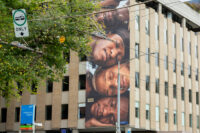
PHOTO 2022 Open Call Artists
10.1.23
PHOTO 2022's award-winning outdoor program included exhibitions by 11 artists from around the world selected through the Open Call in response to the theme Being Human. In the lead up to the Open Call for PHOTO 2024, we reflect on these Open Call artists and their presentations across Melbourne, from Parliament Gardens to Southbank Promenade.
Madeline Bishop (AU)
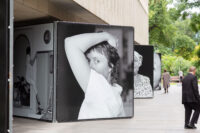
Madeline Bishop PHOTO 2022 by J Forsyth
‘So I sew stitches’ presents a role play, as well as a series of images, in which artist Madeline Bishop invites her friends and family to ‘refer her to somebody that they had never met’. Bishop captured her subjects in their own homes, seeking to explore the resulting dimensions of the relationship between them and herself after being introduced in this way.
Bishop’s photographic and video works explore relational dynamics and tensions between distance and closeness ‘using a performative and constructed approach to dissecting the relationship between photography and intimacy’.
Richmond Kobla Dido (GH)
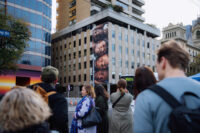
‘Men Do Not Cry’ captures four subjects in a moment of softness, representing a temporary removal from the taboo associated with male emotion, prevalent in their respective communities. Born in Accra, Ghana and now based in Sydney, artist, photographer and creative director, Kobla Dido, works across a range of genres to document the lived experiences of Black people.
The aim of his work is to create space for the storytelling and visual documentation about the African diaspora, in order to encourage a sense of connection and understanding between his subjects and their viewers.
“PHOTO 2022 has allowed me to view my work in a completely new way and opened my mind to the potential impact of what I’m doing.”—Richmond Kobla Dido.
Alexandra Lethbridge (UK)
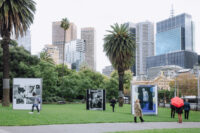
Hong Kong-born, UK based conceptual artist and photographer, Alexandra Lethbridge, examined the everyday occurrence of unspoken forms of communication in The Archive of Gesture. Combining found images, still life photography and digital interventions, Lethbridge references Greek statues, with missing and broken-off limbs, throughout the series. Deception, misdirection, misinformation, visual truth and the cognitive processing and consumption of information are all recurring themes within Lethbridge’s work.
At PHOTO 2022, The Archive of Gesture was exhibited on 3 metre tall frames in Parliament Gardens.
What was your impression of PHOTO 2022?
“PHOTO 2022 was beautifully curated and produced to a high standard… having worked with a lot of festivals, I would put this up there as one of the best experiences I’ve had.”
—Alexandra Lethbridge.
Jenny Lewis (UK)
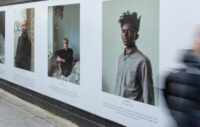
Jenny Lewis captures a non-judgemental and unobstructive glimpse into the lives of a creative community in East London with her series ‘One Hundred Years’. Sprawled across a vibrant stretch of over one hundred metres, of the Metro Tunnel hoardings in Melbourne, Lewis’ life-sized portraits invite viewers into the moments of sorrow, joy and predicament: through the stories of residents at various ages. She describes the series as an exploration of ‘aging, connection and identity’.
Lewis has lived in Hackney for over 25 years and is an award-winning portrait photographer.
“Being selected for a major international festival validates my practice and the work I create… the quality of the work selected [across PHOTO 2022] and the inventive ways it was delivered left me feeling inspired and excited for what’s to come.”—Jenny Lewis
Luvuyo Equiano Nyawose (ZA)
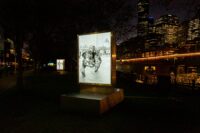
Working between eThekwini, Johannesburg & Cape Town, South Africa, Luvuyo Equiano Nyawose is an artist, curator, filmmaker and researcher exploring intimacy, public communion and Black-Oceanic humanities.
Located at the Southbank Promenade, throughout PHOTO 2022, Luvuyo’s ‘Ibhish’ documents Black beach goers along the Durban beachfront, who have become the subject of abjection in what used to be a predominantly white area. Nyawose uses film and aerial photography to explore ‘the self in relation to the ocean’, the otherwise invisibility of Black social life and leisure as a means for survival, highlighting the beach as a meeting point for Black people in the summer.
Sarah Pannell (AU)
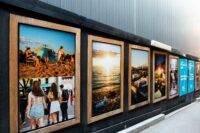
‘The people are the times’ reminisces on the joy and trepidation among Melbourne residents, the first summer weeks following over two years of lockdowns.
Erring on the side of caution, yet eager to resume their lives, Pannell’s portraits depict the vibrance of popular social settings a wedding party traipsing the top-end of Bourke St and China Town at golden hour, overflowing with pedestrians.
‘The people are the times’ reminisces on the joy and trepidation among Melbourne residents, the first summer weeks following over two years of lockdowns.
Erring on the side of caution, yet eager to resume their lives, Pannell’s portraits depict the vibrance of popular social settings a wedding party traipsing the top-end of Bourke St and China Town at golden hour, overflowing with pedestrians.
Pannell often explores culture, landscape, tradition and community with her photography. She travels often to observe and explore shifting cultures and changing spaces.
Apply to the 2024 Open Call now.
Marton Perlaki (HE)
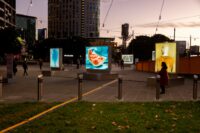
Marton Perlaki explores the beauty of all things temporary in ‘Reminder’. He captures a series of objects – a half-eaten watermelon, melting ice and a sweaty back – caught somewhere between the beginning and end of a process, reminding the viewer of life’s constant flux and highlighting the importance of paying attention to the now.
Perlaki is a Hungarian-born artist, now based in London, who works predominantly within fashion photography.
Misha Vallejo Prut (EC)

Suspended above the vibrant Prahran Market, Misha Vallejo’s Secret Sarayaku, invites viewers to consider the interconnectedness between the planet’s ecology, food systems and the impending threat of climate change on humanity, from the perspective of Indigenous spiritual connections to land.
The images introduce the Kichwa people, native to the Ecuadorian Amazon Rainforest, who leverage cyber-activism on social media platforms to engage people around the world to join their fight against global warming.
Vallejo describes themselves as an audio-visual storyteller whose work borders documentary and art, interested in portraying ‘the lost person and the lost place’ amid environmental and identity issues.
Ioanna Sakellaraki (GR)
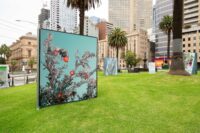
Greek photographer, Ioanna Sakellaraki, embarked on a 5-year exploration of grief and Greek mourning traditions, in ‘The Truth is in the Soil’. After the loss of her father, the process of her own grieving became the lens through which she investigated ancestral rituals, trauma and the passage of time; specifically leading her to the last remaining communities of traditional female mourners on the Mani Peninsula in Greece.
Exploring connections between cultural memory and fiction, Sakellaraki’s work emphasises the photographic object, process and encounter painting a primitive yet futuristic vision of places and people.
Henry Wolff (AU)
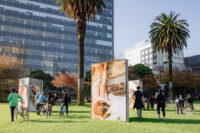
Intimate portraits of entanglements make up Together, Henry Wolff’s series of speculative images exploring the complexities of relating. The series depicts partnerships – some pre-existing and some performative – at various stages of maturity, showing body language as a channel ‘to our interiority’. The work explored vulnerability and human connection, via an empathetic lens, to foster moral virtues of care, compassion and love.
At PHOTO 2022, Together was presented on 3 metre tall frames in Parliament Gardens.
“As I am also an early career practitioner, I feel this exposure is likely to be invaluable in helping build towards future steps in my career.